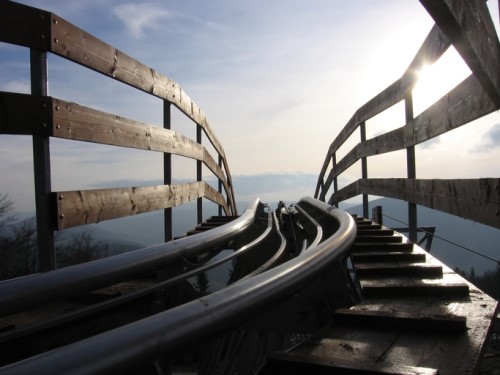

Thrill seekers are buzzing with excitement after Canada’s Wonderland announced it will unveil the “longest, fastest and tallest dive roller coaster in the world” in 2019. The Yukon Striker coaster will soar across 3,625 feet of track at a max speed of 80 mph (130 km/h) and will feature a 90-degree, 245-foot drop into an underwater tunnel.
The record-breaking ride at the amusement park in Vaughan, Ontario (about one hour from Toronto) has other features to enhance its thrill capacity. The Yukon Striker will hold and dangle riders for three seconds before dropping them down the vertical 245-foot descent. To make matters worse, for those with a weak stomach for rides, the Striker will have floorless seating, which park officials say is for “enhanced visibility”.
As scary and stomach-churning as the Yukon Striker may seem, it’s likely going to be one of the safest things a visitor might be doing at a huge amusement park like Wonderland, according to Kevin Dannemann, vice president and general manager at K&K Insurance Canada.
“A lot of people think the rides are the greatest exposures at big amusement parks, but they’re actually probably one of the safest things you could be doing. Rides like the Yukon Striker have to meet the rules and regulations set out by the Technical Standards and Safety Authority (TSSA), and parks have to follow the maintenance and inspection recommendations of the ride manufacturer,” Dannemann told Insurance Business. “They’re generally very safe and secure in terms of how they’re operated, as long as the manufacturer’s guidelines are being followed. The Yukon Striker looks like a pretty cool ride – I just don’t know if I personally have the stomach for it.”
Would you have the stomach for this?
The rides might be secure but running an amusement park is still a huge risk management operation. A lot of the risks would fall under a commercial general liability policy and can be mitigated if parks operate appropriately, Dannemann explained. The most common claims arise from things like slips, trips and falls, or tainted food from one of the food trucks or vendors. There’s always a danger of awe-stricken visitors letting their eyes wander to rides rather than watching where they’re going, which can also lead to accident or injury.
“People can get injured from a malfunctioning ride, but parks should be carrying out daily inspections of rides prior to opening the grounds to prevent that from happening,” Dannemann commented. “They should make daily visual inspections of all cables, beams and any metals in order to look for any fatigue, and they should keep detailed log-books of these inspections.
“An amusement park will also want to have a public announcement system in place to alert visitors of any security threats or if there’s inclement weather approaching. With regards to bad weather, parks will want to have a doppler radar system on site with a qualified person manning it and making informed decisions. The new Yukon Striker is set to go 245-feet high, so there will have to be requirements in terms of how far out lightning strikes before the ride is shut down for bad weather conditions.”
K&K Insurance has been offering amusement park insurance and risk management across Canada and the US for at least 50 years. One thing the firm always requires an insured to have in place is a proper emergency risk management plan. They will work with the park and the broker to ensure an appropriate plan is implemented.
“There needs to be plans in place to handle the need for a mass evacuation or security threat,” said Dannemann. “Parks need to have experienced staff who are trained to handle emergencies, whether that’s a security threat, an accident or inclement weather.”
